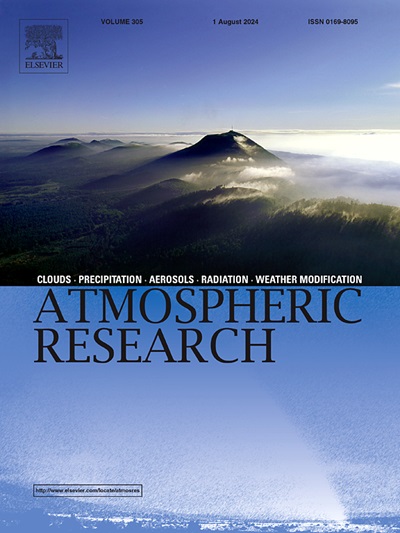大湄公河次区域早春土壤水分对南海夏季季风起始年际变化的影响
IF 4.5
2区 地球科学
Q1 METEOROLOGY & ATMOSPHERIC SCIENCES
引用次数: 0
摘要
本研究利用观测分析和数值试验研究了大湄公河次区域(GMS)早春(3-4 月)土壤水分对南海夏季季风(SCSSM)起始年际变化的影响。研究发现,当湄公河次区域早春夏季季候风较湿时,西风异常在南海占主导地位,这与夏季季候风的提前到来相对应,反之亦然。物理机制分析表明,早春SM正异常通过调节地表潜热通量和显热通量降低了当地地表气温。持续的地面异常降温导致对流层中层负的位势高度异常,并进一步诱发北太平洋西部副热带高压在五月份东退。南中国海上空的异常气旋有利于南中国海气旋移动的提前发生。利用大气-陆地耦合模式(CAM6-CLM5)进行的敏感性试验证实了连接大海洋生态系统早春SM变率和随后SCSSM开始的关键物理过程。具体地说,较干旱实验中的南亚高纬度风暴起始日比较潮湿实验中的起始日晚 11 天。本结果对 SCSSM 开始日期的预报有一定影响。本文章由计算机程序翻译,如有差异,请以英文原文为准。
Impacts of early spring soil moisture over the Greater Mekong Subregion on the interannual variation of South China Sea summer monsoon onset
This study investigates the influence of early spring (March–April) soil moisture (SM) over the Greater Mekong Subregion (GMS) on the interannual variation of South China Sea summer monsoon (SCSSM) onset, using observational analyses and numerical experiments. It is found that when early spring SM over the GMS is wetter, westerly anomalies dominate the South China Sea, corresponding to an early onset of the SCSSM, and vice versa. The analyses of physical mechanism show that the positive anomalies of early spring SM decrease local surface air temperature by adjusting the surface latent heat flux and sensible heat flux. The persistence of anomalous ground cooling contributes to negative geopotential height anomalies in the middle troposphere, and further induces the eastward retreat of western North Pacific subtropical high in May. The anomalous cyclone over the South China Sea favors the early onset of SCSSM. The key physical processes linking the variability of early spring SM over the GMS and the following SCSSM onset are confirmed by the sensitivity experiments using a coupled atmosphere–land model (CAM6–CLM5). Specifically, the onset date of the SCSSM in the drier experiment is 11 days later than that in the wetter experiment. The present results have implications for the forecast of SCSSM onset.
求助全文
通过发布文献求助,成功后即可免费获取论文全文。
去求助
来源期刊

Atmospheric Research
地学-气象与大气科学
CiteScore
9.40
自引率
10.90%
发文量
460
审稿时长
47 days
期刊介绍:
The journal publishes scientific papers (research papers, review articles, letters and notes) dealing with the part of the atmosphere where meteorological events occur. Attention is given to all processes extending from the earth surface to the tropopause, but special emphasis continues to be devoted to the physics of clouds, mesoscale meteorology and air pollution, i.e. atmospheric aerosols; microphysical processes; cloud dynamics and thermodynamics; numerical simulation, climatology, climate change and weather modification.
 求助内容:
求助内容: 应助结果提醒方式:
应助结果提醒方式:


